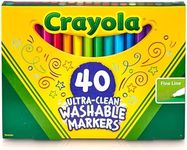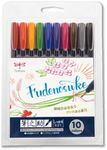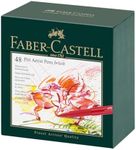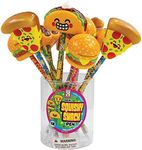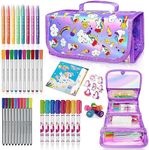Buying Guide for the Best Coloring Pens
Choosing the right coloring pens can greatly enhance your artistic experience, whether you're a professional artist, a hobbyist, or someone who enjoys coloring as a relaxing activity. The key to finding the best coloring pens for your needs is to understand the different specifications and how they align with your personal preferences and intended use. Here are some important factors to consider when selecting coloring pens.Ink TypeThe ink type in coloring pens can vary, including water-based, alcohol-based, and gel-based inks. Water-based inks are great for blending and are less likely to bleed through paper, making them ideal for coloring books and detailed work. Alcohol-based inks are known for their vibrant colors and quick drying times, suitable for professional illustrations and marker art. Gel-based inks offer smooth writing and are often used for adding highlights or special effects. Choose the ink type based on your project needs and the paper you will be using.
Tip SizeTip size refers to the thickness of the pen's point and can range from very fine to broad. Fine tips (0.1mm to 0.5mm) are perfect for detailed work and intricate designs, while medium tips (0.6mm to 1.0mm) are versatile for both detailed and larger areas. Broad tips (over 1.0mm) are best for filling in large spaces and creating bold lines. Consider the type of artwork you plan to create and choose a tip size that matches your need for precision or coverage.
Color RangeThe color range of a pen set determines the variety of shades available to you. Smaller sets may offer basic primary and secondary colors, while larger sets can include a wide spectrum of hues, tints, and shades. If you are working on projects that require subtle color transitions and a rich palette, opt for a larger set. For simpler projects or beginners, a smaller set with essential colors may suffice. Think about the complexity of your artwork and how much color variety you need.
BlendabilityBlendability refers to how well the colors mix together when applied. Some pens are designed to blend seamlessly, allowing for smooth gradients and color transitions. This is particularly important for artists who want to create realistic shading and depth. Water-based and alcohol-based pens typically offer good blendability. If blending is a key part of your technique, look for pens that are specifically marketed for their blending capabilities.
DurabilityDurability encompasses both the longevity of the pen's ink and the robustness of the pen itself. High-quality pens should have ink that lasts a long time without drying out and a sturdy construction that can withstand regular use. If you plan to use your pens frequently or for professional work, investing in durable pens will save you from having to replace them often. Consider how often you will use the pens and in what conditions to determine the level of durability you need.
ErgonomicsErgonomics refers to how comfortable the pen is to hold and use over extended periods. Pens with ergonomic designs often have features like cushioned grips, balanced weight, and non-slip surfaces. This is especially important if you spend a lot of time coloring or have hand issues such as arthritis. Choose pens that feel comfortable in your hand and allow you to work for longer periods without discomfort.



